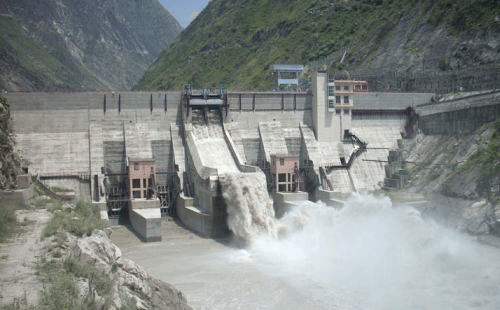Various estimates place the hydropower potential of Himachal Pradesh (HP) between 21,000 to 23,000 Megawatt (MW) of which 5 of its river basins Satluj, Beas, Ravi, Chenab and Yamuna have an estimated potential of 10,065, 4,355, 2,275, 2650 and 625 MWs respectively.
With such gargantuan potential, the contradictions in the hydro-power and dams debate, conceptualized within the wider development discourse, are nowhere more apparent than in HP. With rampant urbanization coupled with increased consumption patterns characterizing modern India after the incorporation of the New Economic Policy (NEP), the state of HP, owing to its unique location in the Himalayan landscape, has been pushed to support the Indian state’s claims for industrial efficiency and economic progress.
Support Independent Journalism Complete Your Membership
Choose Your Membership
HP, in brief, has a very unique history when it comes to utilization of waters for electricity generation. Most expansion in the initial stages was conceptualized under what is termed as ‘minor’ and ‘medium’ projects in technical parlance. HPs ‘Renewable Energy Strategy’ was prepared by the erstwhile Planning Commission in the 10th Five Year Plan (2002-2007) with the terms of reference including assessment of HPs sectoral energy demands, domestic resources, development of a policy on hydel and renewable sources of energy, encouraging private sector participation, recommending suitable regulatory mechanisms and examining the role of the government. Drawn from such recommendations, guided by general policy considerations in HPs New Industrial Policy, 1971 and stimulated by a perception that with existing and planned industrial development, electricity demand would only increase in future, HP delineated much of its hydro-power strategy. This policy was last amended in 1991 with an objective of balancing inter-sectoral developments and the goals of realizing enhanced human development of the people of the state – power sector, with a possibility of integrating public-private partnership, was identified as a thrust area.
Barring a few notable exceptions, a majority of major and medium projects, as planned and implemented in HP, are fundamentally different from those executed elsewhere in India. While most hydro-power projects are built over ground, the ones in HP have been constructed deep inside a mountain excavating millions of tons of earth utilizing complex engineering and hydro logical techniques. With the reservoir usually being located at the top of the mountain, water is diverted by gravitational flow through a network of trans-mountain tunnels and power stations to be finally released into the rivers. Only a small percentage of such projects are visible over ground (ordinarily, the reservoir, entry to the project and spill bays for water discharge).
Owing to their relative ‘invisibility’, local public culture perceives them to have minimal social, cultural, economic and environmental impact. Since the impacts of power projects are not immediately visible, as they are elsewhere (like the Sardar Sarovar Project, Tehri Dam etc.), and given that they displace few or no people, mobilizations around issues of resettlement and rehabilitation are far less in HP. Also, design aspects of the projects ensure that there is minimal loss of visible forest cover. Further, since the projects are demarcated as run-of-the-river, there is barely any contestation with regard to the usage of waters too (this aspect too is undergoing change as discussed later). This perhaps explains why the scale of opposition to power projects in HP is localized and limited to a handful of environmental activists.
This article however, argues that the manner in which the public and policy culture in HP imagines the meta narrative of development constitutes the problem in itself. Firstly, the fact that HP lies in Zone V (seismically most active zone and susceptible to earthquakes to the magnitude of 8 or more on the Richter scale) can hardly be lost to planning for hydro power in the region. Added is the fear that impounding of water in big dams may accentuate big mass and pressure (like in the case of Parichu lake and the Thalot tragedy), enough to initiate seismic activity.

http://www.hpsdma.nic.in/ResourceList/Maps/EqHimachal.pdf
Secondly, most of hydropower planning in HP ignores the fragility of the Himalayas as a young mountain range and its vulnerability to heavy construction and tourism. Shockingly, ‘Cumulative Impact Assessments’ and carrying capacity studies under ‘Impact Assessment Studies’ are optional under law. Analogous to the fact that dams are hardly able to ensure energy security of India, they encompass an activity, which is construction-intensive involving massive blasting, excavation, debris dumping, movement of heavy machinery and diversion of forests and rivers etc. – the cumulative impact of which on the fragile Himalayan ecology is overlooked. Since, the so-called projections on energy security are variable; the construction of projects too is continuous – with valid probability of them being modified. During fieldwork the author visited, in a distance of about 70 kilometers between Duttnagar (near Rampur Bushahr) and Wangtoo (Kinnaur), 3 projects Sanjay Gandhi Vidyut Pariyojna, Nathpa Jhakri Hydropower Station and Rampur Hydro Power Station, all of which are operational. Of the 3, the former two were conceived as run-of-the-river projects and the third in tandem with Jhakri Hydro-power Station. In an ideal situation, the former two should have an independent reservoir from where the waters would be directed through the pen stock to the turbines and finally allowed to rejoin the river through an outlet. With these projects developing interconnected pen stocks and re-routing water through them, besides the probability of increasing pressure on the mountains that of the river regenerating and reviving is almost negligible. The locals while affirming to the river running dry in stretches added that over the years, water release during lean seasons has substantially decreased.
Thirdly, HP enacted the Disaster Management Act (DMA) on 23rd December 2005, which specifically mentions that it shall initiate “continuous and integrated process of planning, organizing, coordinating and implementing measures, which are expedient for prevention of danger or threat of any disaster; mitigation or reduction of risk of any disaster or its severity or consequences; capacity-building; preparedness to deal with any disaster; prompt response to any threatening disaster situation or disaster; assessing the severity or magnitude of effects of any disaster; evacuation, rescue and relief; and rehabilitation and reconstruction”. Despite, its enactment and regardless of the existence of a statutory nodal office of the State Disaster Management Authority (SDMA) and District Disaster Management Authority (DDMA), the state authorities were found to be wanting and unaware of the Standard Operating Procedures (SOPs) when tragedy struck at Thalot. While HP is obligated under law to enact its own DMA, taking cognizance of its local conditions and dangers under the National Disaster Management Act (NDMA) [2005]; appallingly, its NDMA and SDMA Acts are a verbatim copy of each other indicating the disenfranchisement of responsive mechanisms from localized realities.
Fourthly, hydro power requires constant up gradation of existing infrastructure (roads) to accommodate heavy machinery. With relentless blasting of roads for widening, erosion of loose strata leaves the mountain vulnerable to landslides – a trend witnessed by the author for almost past 20 years throughout HP. With supposedly better infrastructure and relaxing of restrictions on movements (especially, in the border districts of Kinnaur and Lahoul & Spiti), even peripheral areas of the state are witnessing increasing inflow of tourists (the total numbers of tourists visiting HP in 2013-14 stood at 1,51,29,835 of which 1,47,15,586 were domestic and 4,14,249 foreign). To accommodate them and their consumption-based lifestyles, indiscriminate construction is undertaken giving impetus to unscientific and illegal mining of boulders, pebbles, sand and gravel.
Fifthly, HP on account of sharing almost 200-250 kilometers of its eastern borders with China witnesses heavy expansion to accommodate infrastructural demands placed by the defense authorities. This aspect has three characteristics: one, that continuous construction and maintenance is carried out in highly mountainous and vulnerable regions of HP; two, given the undefined nature of the border, infrastructure has be sustained at a state of defense readiness; and three, unvarying troop and equipment movement puts additional pressure on an already fragile landscape.
Sixthly, in India, transmission and distribution losses have been officially indicated as 23 per cent of the total electricity generated. Considering this, if the total electricity generated in HP is 23,000 MW, then transmission losses are pegged at almost one-fourths at 5,290 MW. However, independent agencies such as Tata Energy Research Institute (TERI) have estimated transmission losses to be as high as 50 per cent in some states. Experts then have called for initiating measures that increase efficiency of existing projects rather than constructing new ones.
Even if we disregard the social and environmental costs imposed by dams and development on the ecosystem and the people of HP and argue only on the basis of technical claims, then too, it is widely accepted that such assertions are unsustainable given the exorbitant costs, long gestation periods and poor productivity of hydro-power projects. With most dams operating on muddy and turbulent Himalayan Rivers, they are vulnerable to siltation and thus, disproportionately utilized. Furthermore, project overruns exacerbate revisions and ensure under-utilization.
Additionally, the question remains whether electricity is representative of the resource it is made out to be. In 2014-15, 1/5th of the total resources of India were allocated to the power sector alone underscoring the importance that Government of India (GoI) places on this sector. However, many studies undertaken by the government and other agencies indicate its record as abysmal, especially if one considers that the only energy accounted for is commercial and the rest is consumed free, as it is collected free of charge as fuel wood at great expense of human labour. Further, the futility of electricity as a resource for progress is only enhanced if its relationship with the needs of the poor are ascertained (it is estimated that only 14 per cent of the Indian villages can afford electricity).
Since HP has harnessed the highest hydropower potential in the entire Himalayan region and given the fact that the bulk of hydropower projects envisaged are located in HP, the above patterns of development are typified by hydropower development in the state. Clearly, development symptomatic of such concerns has come at an immense cost for HP, much of which cannot even be quantified. Various studies on hydropower development in the Himalayas coupled with ethnographic evidence suggest that hydropower development in HP is not isolated and shares patterns of development and resistance with its Himalayan counterparts. While mass mobilizations against hydropower projects are not common in HP; several umbrella organizations have emerged recently, under the banner of whom people have begun to register their dissent albeit sporadically. Despite that hydropower projects in HP continue unabated. The need to rethink therefore is urgent and immediate.





